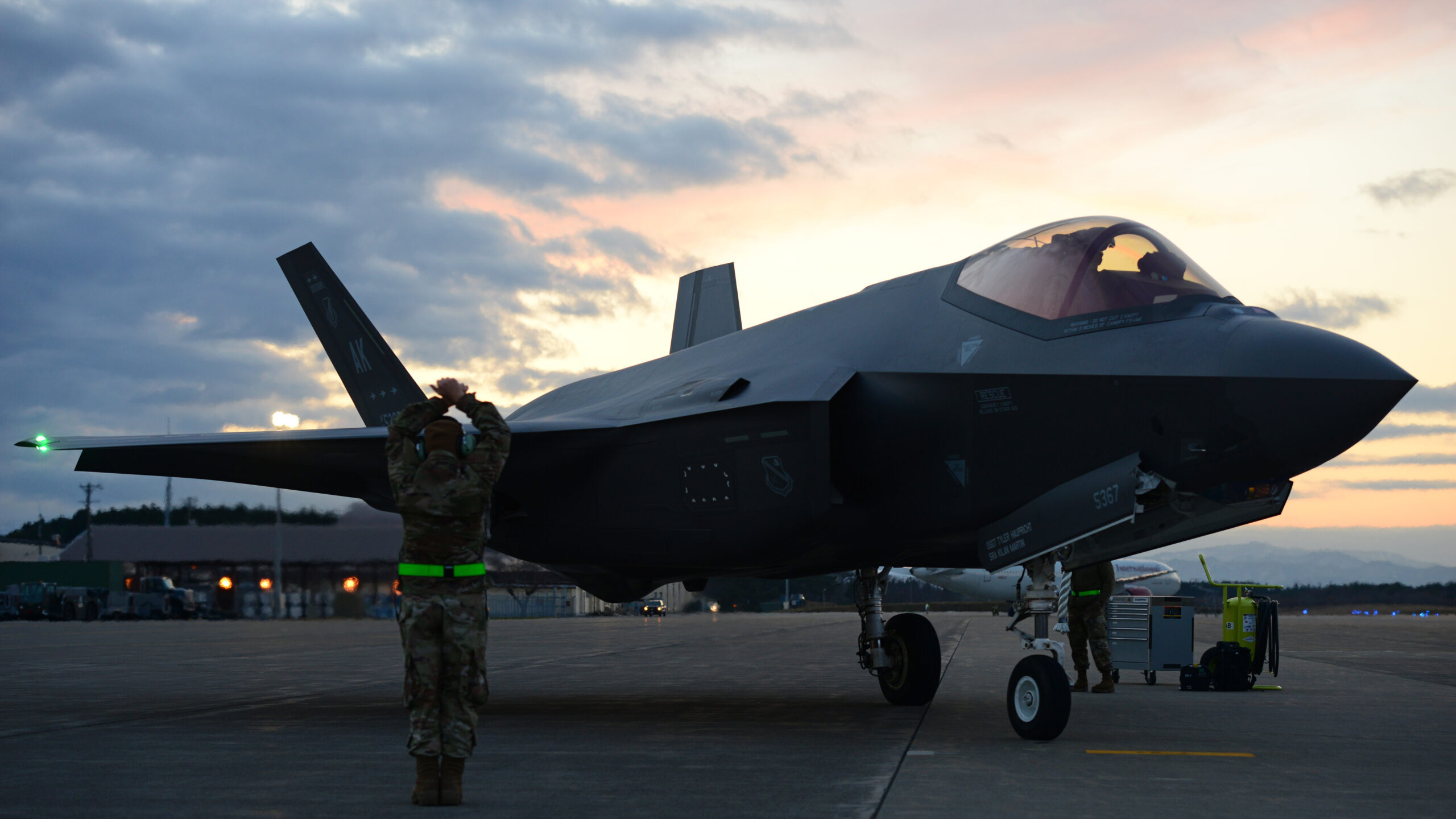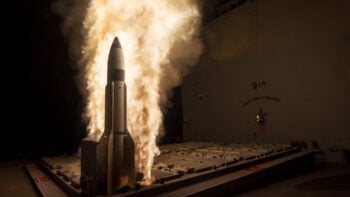
U.S. Marines with Marine Aviation Logistics Squadron (MALS) 31 and Marine Aerial Refueler Transport Squadron (VMGR) 252 refuel and arm two F-35B Lightning II assigned to Marine Fighter Attack Training Squadron (VMFAT) 501 at Marine Corps Auxiliary Landing Field (MCALF) Bogue, North Carolina, Nov. 18, 2021. (U.S. Marine Corps photo by Chief Warrant Officer Bryan Nygaard)
WASHINGTON — Just 55% of the Pentagon’s F-35 Joint Strike Fighter fleet was mission capable as of March 2023, a disappointing statistic driven by factors like a lack of depot capacity, insufficient supply of spare parts and overreliance on contractors, according to a new report from the Government Accountability Office.
The watchdog’s assessment — published days after a Marine Corps F-35B went missing for over 24 hours in South Carolina — highlights a complaint frequently aired by government officials: prime contractor Lockheed Martin, along with its countless subcontractors, were given too much control over sustaining the stealth fighter, a situation officials told GAO is untenable for the program’s future.
“According to DOD officials, over the last several years program officials realized that contractor-led sustainment for the F-35 program was unsustainable due to high costs. Several DOD officials we spoke to during the course of our review expressed significant concern over the costs of contractor labor in the F-35 program,” GAO wrote in its expansive 96-page report [PDF] on sustaining the Joint Strike Fighter.
The fleet’s average mission capable (MC) rate of 55%, defined as when the aircraft can perform one of its tasks, is well below targets of 90% for the F-35A and 85% for the fighter’s B and C variants. Newer aircraft tend to have much better MC rates, but even they are well below the Pentagon’s targets and average closer to 60% for the fleet, according to figures compiled by GAO.
There’s plenty of blame to go around among the various stakeholders that make up the F-35 program. For example, the military services historically failed to prioritize resources for standing up adequate depot capacity, which officials told GAO will not be fully realized until 2027. Delays in bringing those depots online have “had several effects, including slow repair times, a growing backlog of components needing repair, and lower aircraft readiness,” the watchdog found. According to GAO, the lack of depot capacity “contributes up to a 10 percent reduction in the F-35’s mission capable rate.”
Over 10,000 parts as of March 2023 had piled up waiting for repairs due to depot issues, though 70% of those parts were expected to need work, officials told GAO. To ameliorate the issue, the F-35 Joint Program Office ordered new parts instead of fixing existing ones, though program officials told GAO the approach isn’t sustainable.
Beyond the lack of capacity, time required in depot can be extensive. Though GAO found that it’s more than twice as fast to repair a part in depot rather than ship it out to its manufacturer, the Pentagon is still sending 73% of all F-35 parts back to their industry sources for repairs due to a lack of depot capacity. The program estimates that once full depot capacity is reached, about 65% of F-35 parts could be repaired by military service depots. (And depots won’t break the hold contractors have on sustainment, as industry still plays a major role at government-owned depots.)
The DoD also lacks access to certain technical data, which hinders the work of some maintainers and risks delays for depot activities as negotiations over data rights drags on. The problem of data access affects both hardware and software sustainment, GAO found.
The F-35’s procurement strategy is further contributing to repair backlogs in depots, according to the report. While there are technically only three variants of the jet, the aircraft’s high level of concurrency — or overlap between development, procurement and fielding, which can result in the need for retrofits — has effectively created 14 different versions of the aircraft, vexing maintainers and making sustainment less efficient.
“We stand ready to partner with the government as plans are created for the future of F-35 sustainment ensuring mission readiness and enabling deterrence,” Lockheed said in a statement to Breaking Defense.
“We will work with, and be part of, the Sustainment Implementation Working Group (SUSWG) to drive improvements in sustainment across the F-35 enterprise. We are pursuing a more resilient sustainment structure,” Lt. Gen. Mike Schmidt, head of the F-35 Joint Program Office, said in a statement to Breaking Defense. In March, Schmidt shared the low mission capable rates of the fleet with lawmakers and vowed to wage a “War on Readiness” to improve them.
“We must grow our sustainment capacity and efficiency around the world,” Schmidt added today. “To do so, we must stand up our global repair, transportation, and warehousing network at a faster pace, incentivize industry behavior toward desired availability and affordability outcomes, and remain laser focused on increasing all aspects of Mission Capable rates for fielded aircraft.”

A U.S. Air Force F-35A Lightning II from the 356th Expeditionary Fighter Squadron, 354th Air Expeditionary Wing is parked on the flightline at Misawa Air Base, Japan, Dec 6, 2021. (U.S. Air Force photo by Staff Sgt. Sean Martin)
Organizational-level Maintenance; PBL in Doubt
Depot capacity is one of two levels of F-35 sustainment, where maintenance often consists of more intensive repairs. The other level of maintenance is what’s called “organizational-level,” which occurs where aircraft are stationed or deployed and consists of less arduous tasks like replacing parts and conducting inspections. And at that level, GAO found several issues.
The aircraft’s non-mission capable maintenance, which GAO defines as “the percentage of time during which aircraft in the possession of F-35 units are unable to conduct any of their assigned missions because of maintenance,” averaged around 15% in recent years, exceeding a threshold goal of 10%.
GAO’s report highlighted the following factors as contributing to the issue: limited access to technical data, a dearth in spare parts, a lack of support equipment on the flight line and inadequate training for maintainers.
The Pentagon is working through each of these issues, and on the problem of spare parts is considering a new strategy called a performance-based logistics (PBL) contract. The PBL is a proposed five-year deal that would govern the supply of spare parts and tie dollar awards to performance outcomes in lieu of shorter-term sustainment contracts negotiated by the JPO.
After optimism that a deal on the new sustainment contract could be reached this year, it now remains in doubt, with government officials telling GAO they weren’t sure that a key requirement imposed by Congress — that the PBL must either increase readiness or decrease costs — could be achieved. And, even though DoD wants to eventually assume more responsibility for maintenance, the watchdog found “it has yet to determine a pathway to achieve that goal.”
With a deadline of October 2027 approaching for transferring sustainment management from the F-35 Joint Program Office to the military services, GAO warned that work to tackle current challenges, as well as plan for the future, is critical for ensuring the Joint Strike Fighter can perform for decades to come.
“DOD and the military services have the opportunity to take a different path and chart an affordable path forward,” the report says. “The preparedness of our military depends upon it.”
Air Force stands up two new EW squadrons, but still short on personnel
“We have recognized in our threat analysis that we need these capabilities in our wing in order to make our three wing missions executable,” Col. Joshua Koslov said of activating two EW squadrons. “And so that’s exactly what’s driving it.”


























